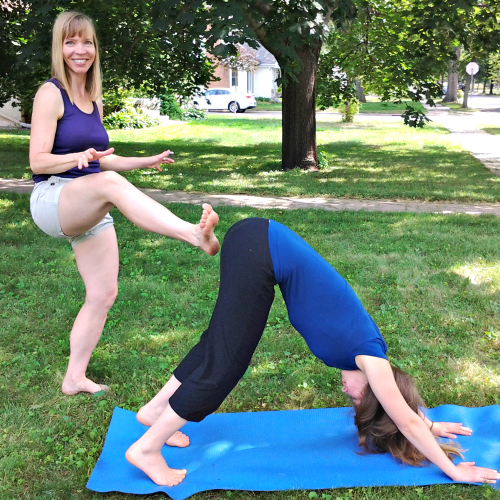Tai Chi Offers a Mind-Body Magic That Can Enrich Your Life.
After that headline, you’ve got to know that I love yoga. Seriously. I have a regular yoga practice. I do at least a few poses every single day. And I’m a certified yoga teacher.
As wonderful as yoga is, here’s a shocker: Yoga is not the Be All and End All that it’s cracked up to be. Man/Woman cannot live on yoga alone.
Well, maybe you can.
I did.
I was a serious mat rat for years. But my steady diet of yoga left me craving… something more.
Apples, for example, are yummy and help keep the doctor away, but wouldn’t it be nice to eat oranges, too?
The fact is, tai chi offers its own brand of body-mind magic that yoga simply can’t.
Let’s start with key elements that tai chi and yoga share. Both are moving meditations and good for your health. Both focus on the breath, teach mindfulness and can be deeply spiritual experiences and ways of life. Both tai chi and yoga are practiced by millions, many of whom are deeply, seriously, even insanely passionate about them.
Here, coming at you from someone who loves yoga, are five ways that tai chi kicks yoga’s butt:
Tai chi is a martial art.
You can use it to frickin’ defend yourself (or your kid, cat or cream puff) with tai chi if you need to. Tai chi chuan means “supreme ultimate fist” or “supreme ultimate boxing.” I’m not a rough and tough kind of gal, but I like the cool factor of practicing an ancient martial art.
No matter how graceful and gentle and flowing it appears, each tai chi posture can be deadly. It’s a martial art, remember?
Yoga can certainly make you strong, flexible and calm. It can give you awesome posture. It might make you a better person. But yoga doesn’t teach you how to ward off an attack or deal with a bar-room brawl.
(Yikes! Here’s to hoping that none of us has to deal with attacks or brawls.)
Tai chi teaches you how to move through the space around you.
When you practice yoga, you’re on your mat. Your mat is your space, your world. There’s power and comfort in that. Your mat can be a retreat, a refuge, a safe place to regroup. I love this about yoga!
Tai chi is different. There’s no mat to mark your boundary. Rather, you learn how to move across physical space with strength, fluidity and ease. You learn how to stay grounded and balanced when you move.
Just as tai chi helps you move in the physical realm, it also helps to help you pass through mental and emotional barriers.
Tai chi is flowing, slow, continuous movements.
Flowing slowly and continuously in tai chi feels good. It develops tremendous small muscle control, which contributes to your sense of balance. I find flowing a great way to be mindful.
Are there versions of yoga that emphasize continuous, slow flowing movements? None that I’m aware of. You can certainly flow in vinyasa (synchronized breath-movement) or power yoga. But there’s not the focus on continuous, slow flow like you find in tai chi.
Tai chi gets you—gasp!—touching other people.
“Pushing hands” is a two-person exercise in tai chi. Pushing hands teaches you sensitivity to others and the world beyond. You are “listening” to your partner with your hands, not your ears. It teaches you how to stay tuned in, balanced and relaxed regardless of what the world tosses your way.
You might argue that there’s touch in yoga, too. There are hands-on instructor adjustments. The occasional soothing touch from an instructor during savasana (corpse pose). Or the accidental touching of hands of yogis during full locust or a twist. But these touches don’t teach the give-take, back-forth sensitivity of Pushing Hands in tai chi.
Tai chi is more about connecting (and talking) with other people.
When you experiment with applications in tai chi class, or when you do Pushing Hands, you’re talking with your partner.
Communicating with your partner is both natural and essential. For example, you might say, “I’m going to push your shoulder, then you turn your waist.” Or “How did that feel?” “Did that move work for you?” “Am I ‘getting’ this posture?”
It’s different with yoga. In my experience, yoga is something of a sacred space, a sanctuary. The sign on the door says, “Please observe silence in the yoga room.”
In other words, be quiet. Turn inward. Focus on breath and postures.
As much as I love this aspect of yoga, it also left a void within me. I definitely don’t want to chit-chat or talk with others during yoga class, but I wanted more connections with people.
I craved social interaction. I yearned to develop lasting friendships with more like-minded folks. This just wasn’t happening in my yoga journey.
Tai chi is proving different.
I’m finding tai chi incredibly conducive to building connections with others.
Sure, we turn inward, focusing on the mind-body experience when we do a tai chi form (set sequence of flowing postures). But we talk with our partners during applications and Pushing Hands. We ask questions. We give feedback. We laugh. We connect… and I’m thankful for it. Connecting with others makes me feel good—contented, if you will.
Yoga’s wonderful, but it’s not the Be All and End All (nor should it have to be). Tai chi offers its own brand of mind-body magic that’s well worth exploring.
Whether you are a hard-core yoga devotee, just strike the occasional yoga pose or have never done yoga, promise me this: give tai chi a try. Be open. Be patient. You might find your mind-body and life all the richer for it!
I’d like to hear from you: What’s the top reason you might try tai chi? Or wouldn’t you? Please leave a comment below.
Love elephant and want to go steady?
Sign up for our (curated) daily and weekly newsletters!
Editor: Catherine Monkman
Photos: Author’s Own



Read 68 comments and reply